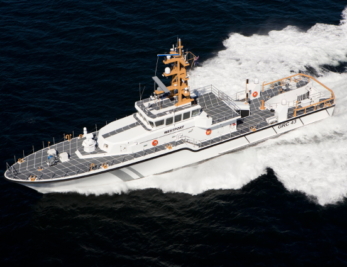GOVERNMENT

Vessel Type: Security Vessel
Vessel Specifications:
- Length – 143 feet
- Full Load Displacement – 212 long tons
- Speed – 32 knots
Benefits from Michigan Wheel Product:
- Significant fuel savings
- Increased top speed
- Cavitation eliminated on strut and rudder
- Vibration reduction
GRC43m Global Response Cutter
The GRC43m is a composite security vessel built by Westport in Westport, Washington. Designed to fulfil missions such as maritime defense, rescue, drug interdiction, and coastal security, the 143′ vessel uses Michigan Wheel propellers and struts to reach speeds of over 32 knots while keeping vibration to a minimum and maximizing efficiency.
In order to boost the performance of the boat, Westport chose wake-adapted equipment from Michigan Wheel. This means that the propellers, struts, and rudders are specifically made to match the boat’s wake, or the region of water disturbed by the boat’s hull. Michigan Wheel worked with Maritime Research Associates, LLC and MTU America to perform computational fluid dynamics (CFD) analysis and apply the results to the design of the GRC43m propellers, rudders, and struts. The propeller blades feature custom pitch, camber, and chord distribution along their spans based on the speed and direction of inflow predicted by CFD. Likewise, the struts and rudders are twisted along their spans based on inflow characteristics. This effort is aimed at maximizing thrust of the propeller while minimizing drag, vibration, and erosive cavitation in the system as a whole.
A high fidelity, wake-adapted design requires detail oriented, high tolerance manufacturing. Michigan Wheel manufactured the propellers and struts through high quality casting and precision CNC machining in order to make the benefits indicated by design analysis a reality.
Wake-adapted propellers, struts, and rudders greatly improve the performance of the GRC43m through drag reduction and propulsive efficiency improvement. Significant fuel savings are estimated when calculating fuel costs per year per vessel compared to typical commercial-off-the-shelf propulsion hardware. Flank speed is estimated to increase by almost 1 knot. Erosive cavitation is eliminated on the strut and rudder. Noise and vibration causing pressure pulses are estimated to decrease in amplitude by 40%.





